Overdentures - “The Solution to Dentures”
Snap In Dentures – Very popular option for the lower jaw. It is an economical & stable solution that works well. The Implants provide anchorage & stability for the denture. We place 2 regular-size Implants in a minimally invasive manner.
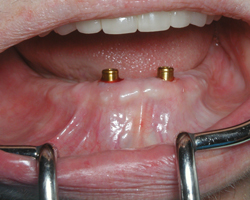
2 Implants
|
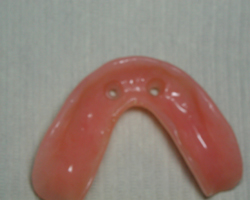
Denture with “Snap In” Attachments |
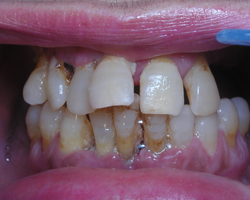
Before Extractions & Implants
|
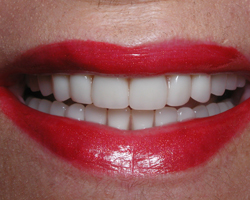
Same Case After –
Implants & “Snap In” Dentures |
Single Tooth Implants
Dental Implants are an effective and lasting alternative to missing teeth. They compare to real teeth and are a better solution because they will not decay or require root canals. Implants are less expensive over the long-term than bridge-work. A bridge has a limited life span and healthy teeth have to be cut down to have a bridge. Once the healthy teeth are cut down , they are more prone to breaking down, needing root canals, getting decay and having to be replaced themselves.
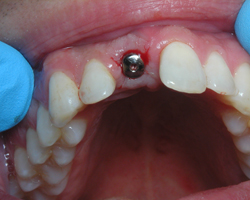
Implant in Place
|
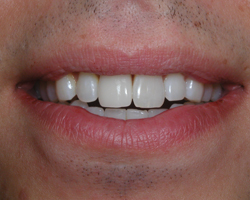
Aesthetic Crown on Implant |
Multiple Teeth Implants
When all teeth are missing or in such condition that they need to be replaced, fixed teeth anchored to dental implants is an excellent permanent solution. Prior to dental implants, there were no fixed solutions available for people who lost all their teeth. Today, it is possible to replace a full jaw with dental implants and a fixed bridge that results in a permanent, stable and highly esthetic solution.
The Main Benefits of Fixed Teeth on Implants
• Is not taken in and out of your mouth / not removable
• Allows the patient to eat and function like having natural teeth
• A stable solution that can serve you for life
• Preserves facial appearance and prevents bone loss
• Eliminate the discomfort and insecurity often associated with loose, ill fitting dentures.
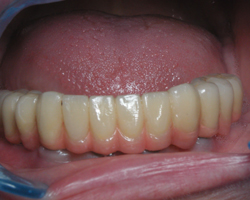
Case 1
|
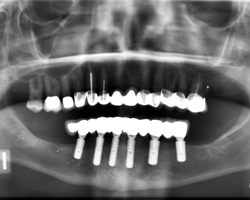
Implant Bridge (12 teeth) |
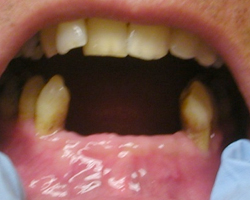
Case 2
|
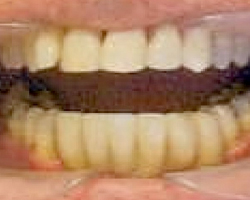
Implant Bridge (6 teeth) on 3 Implants |
Computer Guided Implant Surgery
Computer Guided Surgery
The development of in-office scanning technology, called Cone Beam Computerized Tomography (CBCT), has made dental implant therapy safer and more predictable than ever before. It provides important information regarding the width, shape, quality and volume of bone in cross-section. Once the scan is obtained, the shape of the bone can be clearly seen and a discussion can be conducted of whether procedures such as bone grafting will be required. Other important anatomic landmarks can also be identified such as critical nerve structures, and bony undercuts that cannot be seen with traditional x-rays.
Computer Guided Dental Implant Surgery actually allows the procedure to be “performed” in advance of the surgery. Surgical simulations can be done on the computer, so the exact size and ideal location for the implant is known. In essence, the treatment is completed on the simulator pre-surgically. Recent computer technology breakthroughs enable a surgical guide to be electronically constructed to guide implant placement during surgery. Computer Guided Dental Implant Surgery is typically performed in less than an hour. In most cases, no incisions or sutures are usually needed and therefore post-operative swelling / discomfort is minimal. This state-of-the-art procedure can be used for patients requiring 1 implant to patients in need of full mouth rehabilitation.
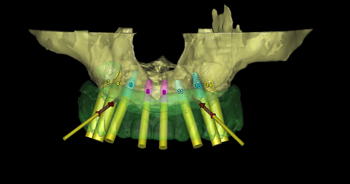
|
Mini Implants
The Mini Implant supported denture – This is an option that helps denture from slipping too much. The mini implant provides more stabilization for the denture, however not much of the plastic / acrylic material can be removed from the denture. The patient is able to snap the denture in and out for cleaning. This is the most economical solution to prevent the denture from falling out of your mouth. |
